Assessment Task 1: Knowledge Questions - BSBWRT301 Manage Meetings
VerifiedAdded on 2023/06/10
|34
|8429
|256
Homework Assignment
AI Summary
This assignment focuses on the 'Manage Meetings' unit and provides comprehensive answers to knowledge questions. The assignment covers essential meeting terminology, including agenda, chair, quorum, and minutes. It outlines meeting structures for both formal and informal settings, detailing key arrangements and the responsibilities of a chairperson before and during a meeting. The document explores the importance of a chairperson monitoring participation and managing group dynamics, including dominant and shy participants, and disruptive behaviors. It defines various roles within a meeting, such as initiator, clarifier, and distractor, and describes different meeting formats, including stand-up meetings and open space technology. The assignment also highlights the advantages of face-to-face meetings, making it a valuable resource for students studying meeting management.
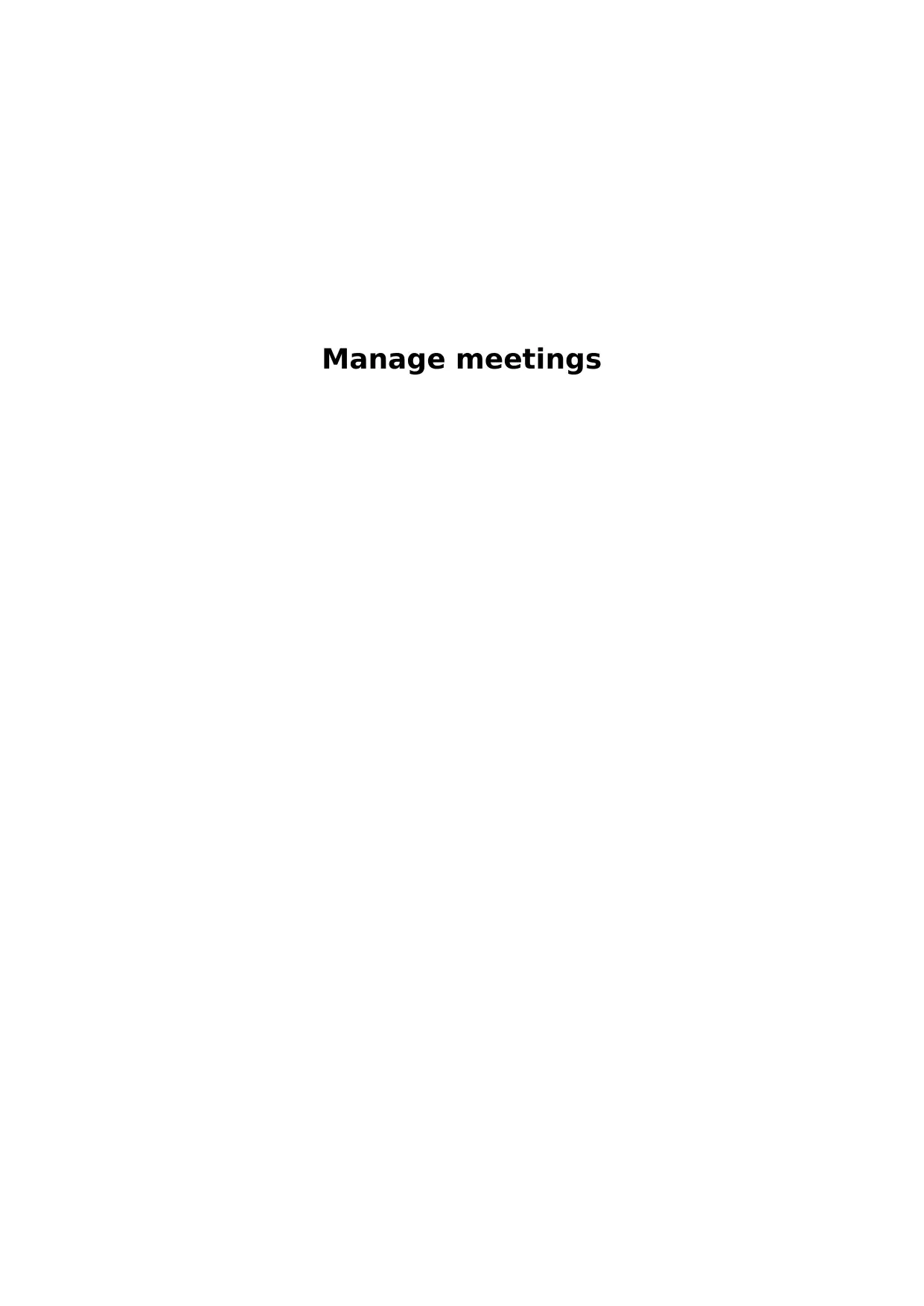
Manage meetings
Paraphrase This Document
Need a fresh take? Get an instant paraphrase of this document with our AI Paraphraser

Introduction........................................................................................................................................ 3
Assessment Task 1: Knowledge questions ......................................................................................4
Assessment Task 2: Project Portfolio.............................................................................................. 10
Assessment Task 1: Knowledge questions ......................................................................................4
Assessment Task 2: Project Portfolio.............................................................................................. 10
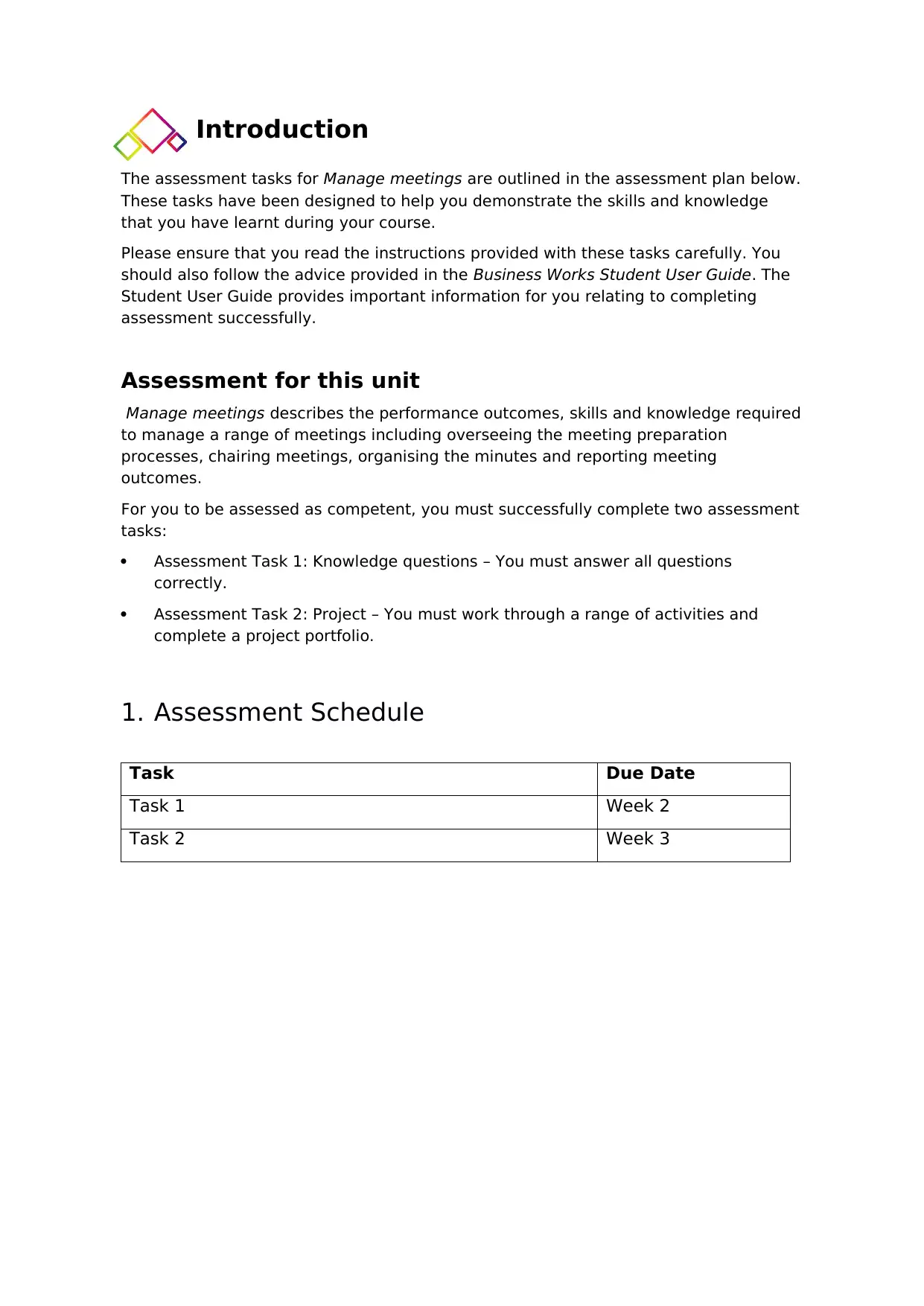
Introduction
The assessment tasks for Manage meetings are outlined in the assessment plan below.
These tasks have been designed to help you demonstrate the skills and knowledge
that you have learnt during your course.
Please ensure that you read the instructions provided with these tasks carefully. You
should also follow the advice provided in the Business Works Student User Guide. The
Student User Guide provides important information for you relating to completing
assessment successfully.
Assessment for this unit
Manage meetings describes the performance outcomes, skills and knowledge required
to manage a range of meetings including overseeing the meeting preparation
processes, chairing meetings, organising the minutes and reporting meeting
outcomes.
For you to be assessed as competent, you must successfully complete two assessment
tasks:
Assessment Task 1: Knowledge questions – You must answer all questions
correctly.
Assessment Task 2: Project – You must work through a range of activities and
complete a project portfolio.
1. Assessment Schedule
Task Due Date
Task 1 Week 2
Task 2 Week 3
The assessment tasks for Manage meetings are outlined in the assessment plan below.
These tasks have been designed to help you demonstrate the skills and knowledge
that you have learnt during your course.
Please ensure that you read the instructions provided with these tasks carefully. You
should also follow the advice provided in the Business Works Student User Guide. The
Student User Guide provides important information for you relating to completing
assessment successfully.
Assessment for this unit
Manage meetings describes the performance outcomes, skills and knowledge required
to manage a range of meetings including overseeing the meeting preparation
processes, chairing meetings, organising the minutes and reporting meeting
outcomes.
For you to be assessed as competent, you must successfully complete two assessment
tasks:
Assessment Task 1: Knowledge questions – You must answer all questions
correctly.
Assessment Task 2: Project – You must work through a range of activities and
complete a project portfolio.
1. Assessment Schedule
Task Due Date
Task 1 Week 2
Task 2 Week 3
⊘ This is a preview!⊘
Do you want full access?
Subscribe today to unlock all pages.

Trusted by 1+ million students worldwide
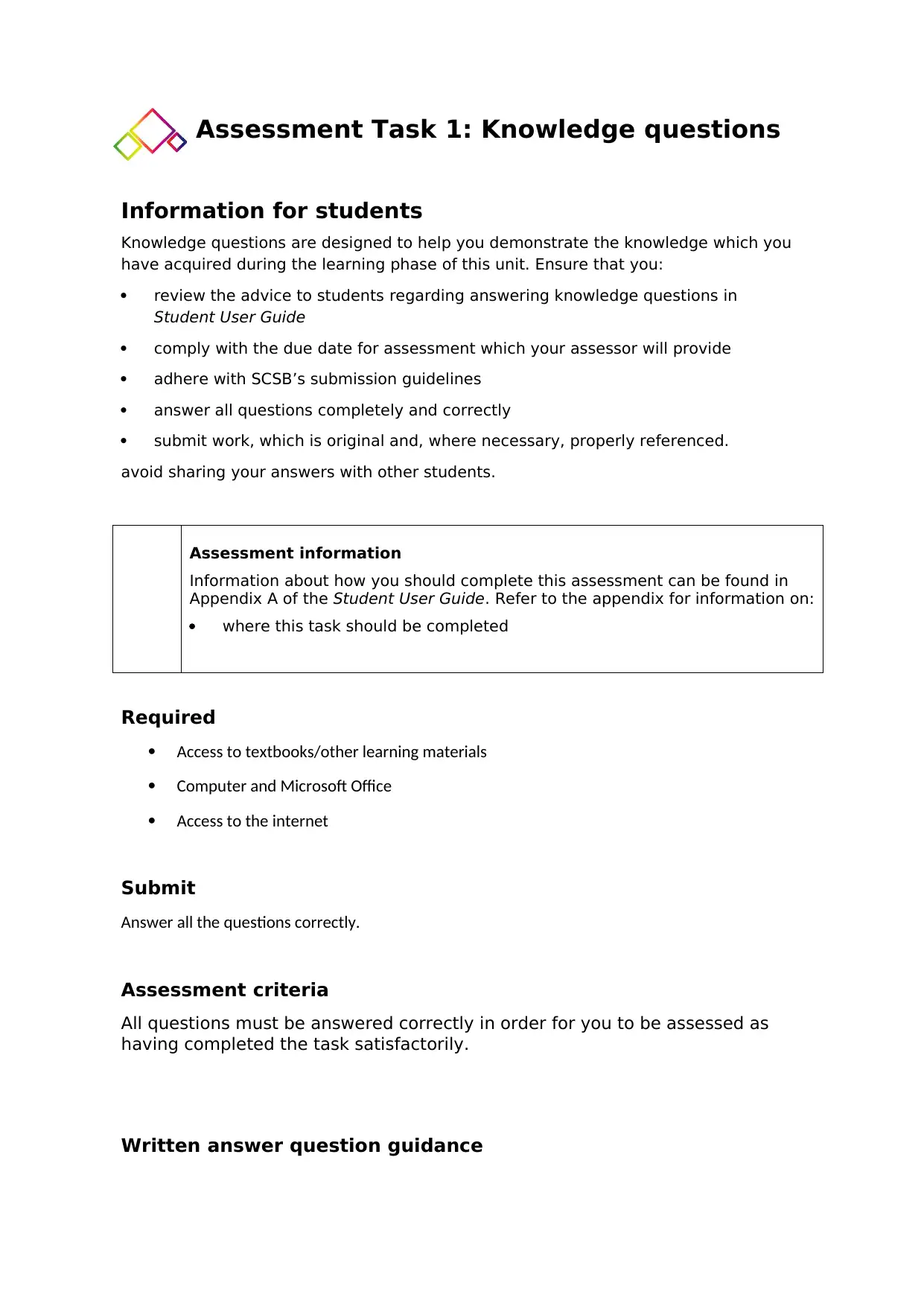
Assessment Task 1: Knowledge questions
Information for students
Knowledge questions are designed to help you demonstrate the knowledge which you
have acquired during the learning phase of this unit. Ensure that you:
review the advice to students regarding answering knowledge questions in
Student User Guide
comply with the due date for assessment which your assessor will provide
adhere with SCSB’s submission guidelines
answer all questions completely and correctly
submit work, which is original and, where necessary, properly referenced.
avoid sharing your answers with other students.
Assessment information
Information about how you should complete this assessment can be found in
Appendix A of the Student User Guide. Refer to the appendix for information on:
where this task should be completed
Required
Access to textbooks/other learning materials
Computer and Microsoft Office
Access to the internet
Submit
Answer all the questions correctly.
Assessment criteria
All questions must be answered correctly in order for you to be assessed as
having completed the task satisfactorily.
Written answer question guidance
Information for students
Knowledge questions are designed to help you demonstrate the knowledge which you
have acquired during the learning phase of this unit. Ensure that you:
review the advice to students regarding answering knowledge questions in
Student User Guide
comply with the due date for assessment which your assessor will provide
adhere with SCSB’s submission guidelines
answer all questions completely and correctly
submit work, which is original and, where necessary, properly referenced.
avoid sharing your answers with other students.
Assessment information
Information about how you should complete this assessment can be found in
Appendix A of the Student User Guide. Refer to the appendix for information on:
where this task should be completed
Required
Access to textbooks/other learning materials
Computer and Microsoft Office
Access to the internet
Submit
Answer all the questions correctly.
Assessment criteria
All questions must be answered correctly in order for you to be assessed as
having completed the task satisfactorily.
Written answer question guidance
Paraphrase This Document
Need a fresh take? Get an instant paraphrase of this document with our AI Paraphraser
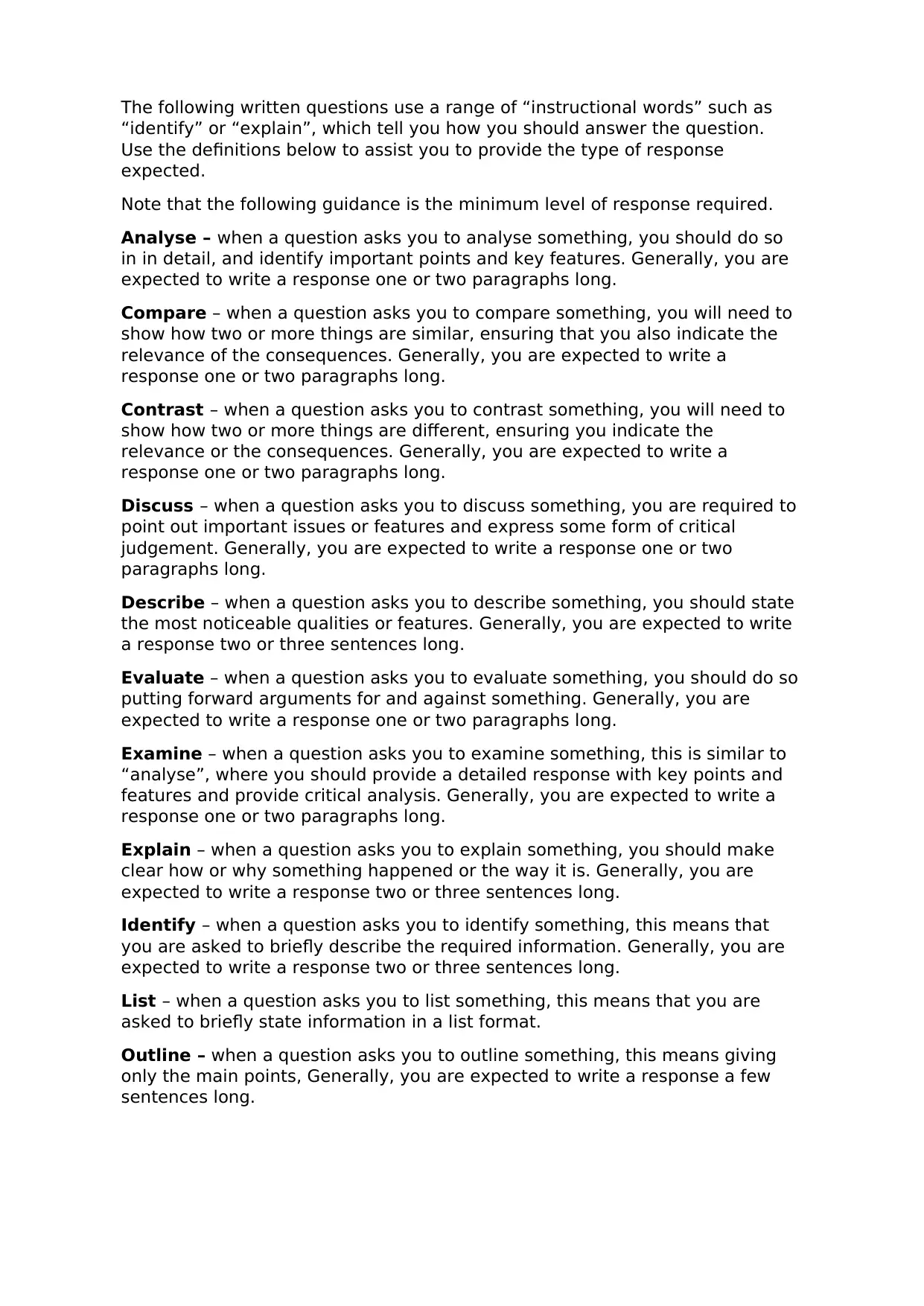
The following written questions use a range of “instructional words” such as
“identify” or “explain”, which tell you how you should answer the question.
Use the definitions below to assist you to provide the type of response
expected.
Note that the following guidance is the minimum level of response required.
Analyse – when a question asks you to analyse something, you should do so
in in detail, and identify important points and key features. Generally, you are
expected to write a response one or two paragraphs long.
Compare – when a question asks you to compare something, you will need to
show how two or more things are similar, ensuring that you also indicate the
relevance of the consequences. Generally, you are expected to write a
response one or two paragraphs long.
Contrast – when a question asks you to contrast something, you will need to
show how two or more things are different, ensuring you indicate the
relevance or the consequences. Generally, you are expected to write a
response one or two paragraphs long.
Discuss – when a question asks you to discuss something, you are required to
point out important issues or features and express some form of critical
judgement. Generally, you are expected to write a response one or two
paragraphs long.
Describe – when a question asks you to describe something, you should state
the most noticeable qualities or features. Generally, you are expected to write
a response two or three sentences long.
Evaluate – when a question asks you to evaluate something, you should do so
putting forward arguments for and against something. Generally, you are
expected to write a response one or two paragraphs long.
Examine – when a question asks you to examine something, this is similar to
“analyse”, where you should provide a detailed response with key points and
features and provide critical analysis. Generally, you are expected to write a
response one or two paragraphs long.
Explain – when a question asks you to explain something, you should make
clear how or why something happened or the way it is. Generally, you are
expected to write a response two or three sentences long.
Identify – when a question asks you to identify something, this means that
you are asked to briefly describe the required information. Generally, you are
expected to write a response two or three sentences long.
List – when a question asks you to list something, this means that you are
asked to briefly state information in a list format.
Outline – when a question asks you to outline something, this means giving
only the main points, Generally, you are expected to write a response a few
sentences long.
“identify” or “explain”, which tell you how you should answer the question.
Use the definitions below to assist you to provide the type of response
expected.
Note that the following guidance is the minimum level of response required.
Analyse – when a question asks you to analyse something, you should do so
in in detail, and identify important points and key features. Generally, you are
expected to write a response one or two paragraphs long.
Compare – when a question asks you to compare something, you will need to
show how two or more things are similar, ensuring that you also indicate the
relevance of the consequences. Generally, you are expected to write a
response one or two paragraphs long.
Contrast – when a question asks you to contrast something, you will need to
show how two or more things are different, ensuring you indicate the
relevance or the consequences. Generally, you are expected to write a
response one or two paragraphs long.
Discuss – when a question asks you to discuss something, you are required to
point out important issues or features and express some form of critical
judgement. Generally, you are expected to write a response one or two
paragraphs long.
Describe – when a question asks you to describe something, you should state
the most noticeable qualities or features. Generally, you are expected to write
a response two or three sentences long.
Evaluate – when a question asks you to evaluate something, you should do so
putting forward arguments for and against something. Generally, you are
expected to write a response one or two paragraphs long.
Examine – when a question asks you to examine something, this is similar to
“analyse”, where you should provide a detailed response with key points and
features and provide critical analysis. Generally, you are expected to write a
response one or two paragraphs long.
Explain – when a question asks you to explain something, you should make
clear how or why something happened or the way it is. Generally, you are
expected to write a response two or three sentences long.
Identify – when a question asks you to identify something, this means that
you are asked to briefly describe the required information. Generally, you are
expected to write a response two or three sentences long.
List – when a question asks you to list something, this means that you are
asked to briefly state information in a list format.
Outline – when a question asks you to outline something, this means giving
only the main points, Generally, you are expected to write a response a few
sentences long.

Summarise – when a question asks you to summarise something, this means
(like “outline”) only giving the main points. Generally, you are expected to
write a response a few sentences long.
(like “outline”) only giving the main points. Generally, you are expected to
write a response a few sentences long.
⊘ This is a preview!⊘
Do you want full access?
Subscribe today to unlock all pages.

Trusted by 1+ million students worldwide
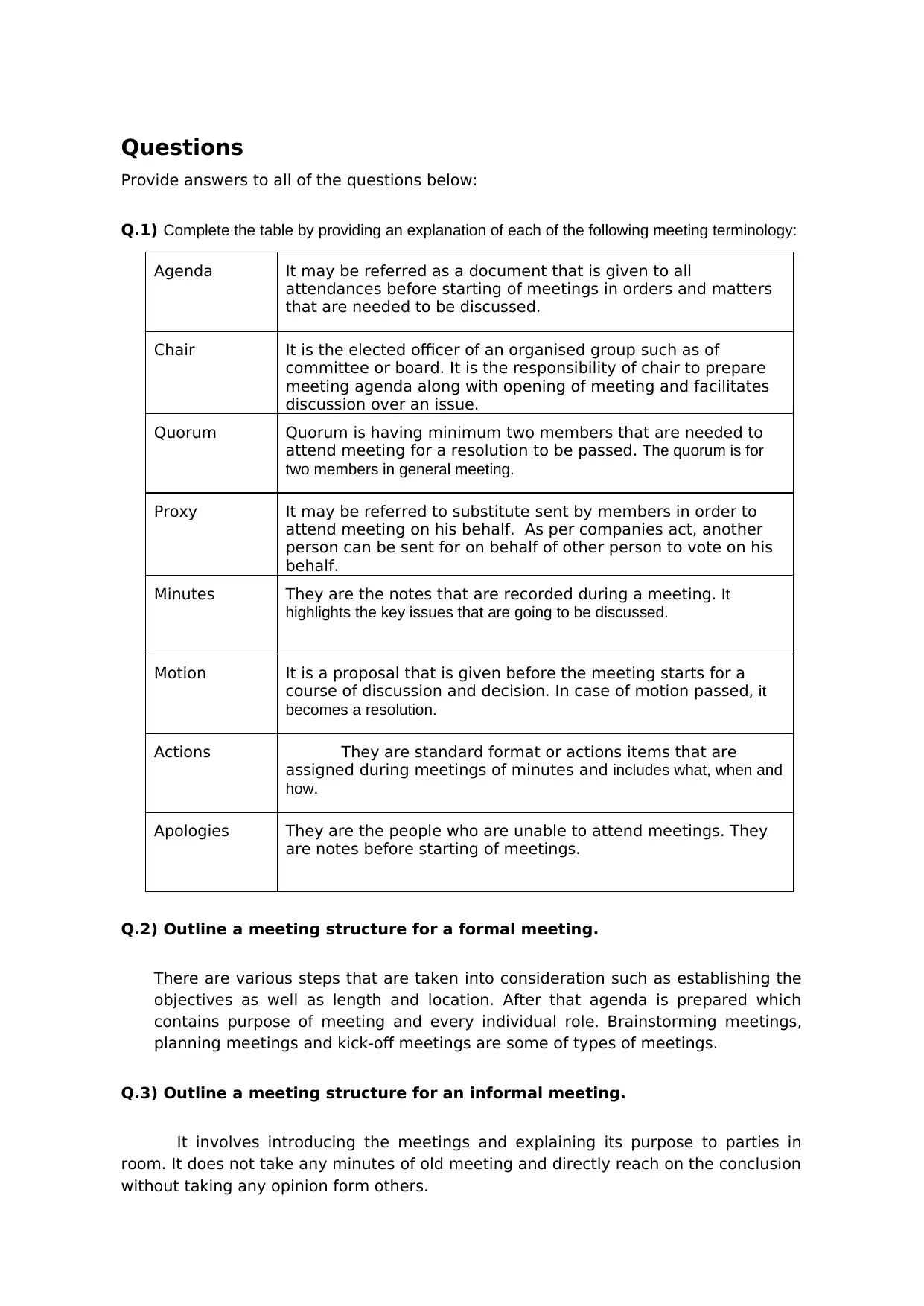
Questions
Provide answers to all of the questions below:
Q.1) Complete the table by providing an explanation of each of the following meeting terminology:
Agenda It may be referred as a document that is given to all
attendances before starting of meetings in orders and matters
that are needed to be discussed.
Chair It is the elected officer of an organised group such as of
committee or board. It is the responsibility of chair to prepare
meeting agenda along with opening of meeting and facilitates
discussion over an issue.
Quorum Quorum is having minimum two members that are needed to
attend meeting for a resolution to be passed. The quorum is for
two members in general meeting.
Proxy It may be referred to substitute sent by members in order to
attend meeting on his behalf. As per companies act, another
person can be sent for on behalf of other person to vote on his
behalf.
Minutes They are the notes that are recorded during a meeting. It
highlights the key issues that are going to be discussed.
Motion It is a proposal that is given before the meeting starts for a
course of discussion and decision. In case of motion passed, it
becomes a resolution.
Actions They are standard format or actions items that are
assigned during meetings of minutes and includes what, when and
how.
Apologies They are the people who are unable to attend meetings. They
are notes before starting of meetings.
Q.2) Outline a meeting structure for a formal meeting.
There are various steps that are taken into consideration such as establishing the
objectives as well as length and location. After that agenda is prepared which
contains purpose of meeting and every individual role. Brainstorming meetings,
planning meetings and kick-off meetings are some of types of meetings.
Q.3) Outline a meeting structure for an informal meeting.
It involves introducing the meetings and explaining its purpose to parties in
room. It does not take any minutes of old meeting and directly reach on the conclusion
without taking any opinion form others.
Provide answers to all of the questions below:
Q.1) Complete the table by providing an explanation of each of the following meeting terminology:
Agenda It may be referred as a document that is given to all
attendances before starting of meetings in orders and matters
that are needed to be discussed.
Chair It is the elected officer of an organised group such as of
committee or board. It is the responsibility of chair to prepare
meeting agenda along with opening of meeting and facilitates
discussion over an issue.
Quorum Quorum is having minimum two members that are needed to
attend meeting for a resolution to be passed. The quorum is for
two members in general meeting.
Proxy It may be referred to substitute sent by members in order to
attend meeting on his behalf. As per companies act, another
person can be sent for on behalf of other person to vote on his
behalf.
Minutes They are the notes that are recorded during a meeting. It
highlights the key issues that are going to be discussed.
Motion It is a proposal that is given before the meeting starts for a
course of discussion and decision. In case of motion passed, it
becomes a resolution.
Actions They are standard format or actions items that are
assigned during meetings of minutes and includes what, when and
how.
Apologies They are the people who are unable to attend meetings. They
are notes before starting of meetings.
Q.2) Outline a meeting structure for a formal meeting.
There are various steps that are taken into consideration such as establishing the
objectives as well as length and location. After that agenda is prepared which
contains purpose of meeting and every individual role. Brainstorming meetings,
planning meetings and kick-off meetings are some of types of meetings.
Q.3) Outline a meeting structure for an informal meeting.
It involves introducing the meetings and explaining its purpose to parties in
room. It does not take any minutes of old meeting and directly reach on the conclusion
without taking any opinion form others.
Paraphrase This Document
Need a fresh take? Get an instant paraphrase of this document with our AI Paraphraser
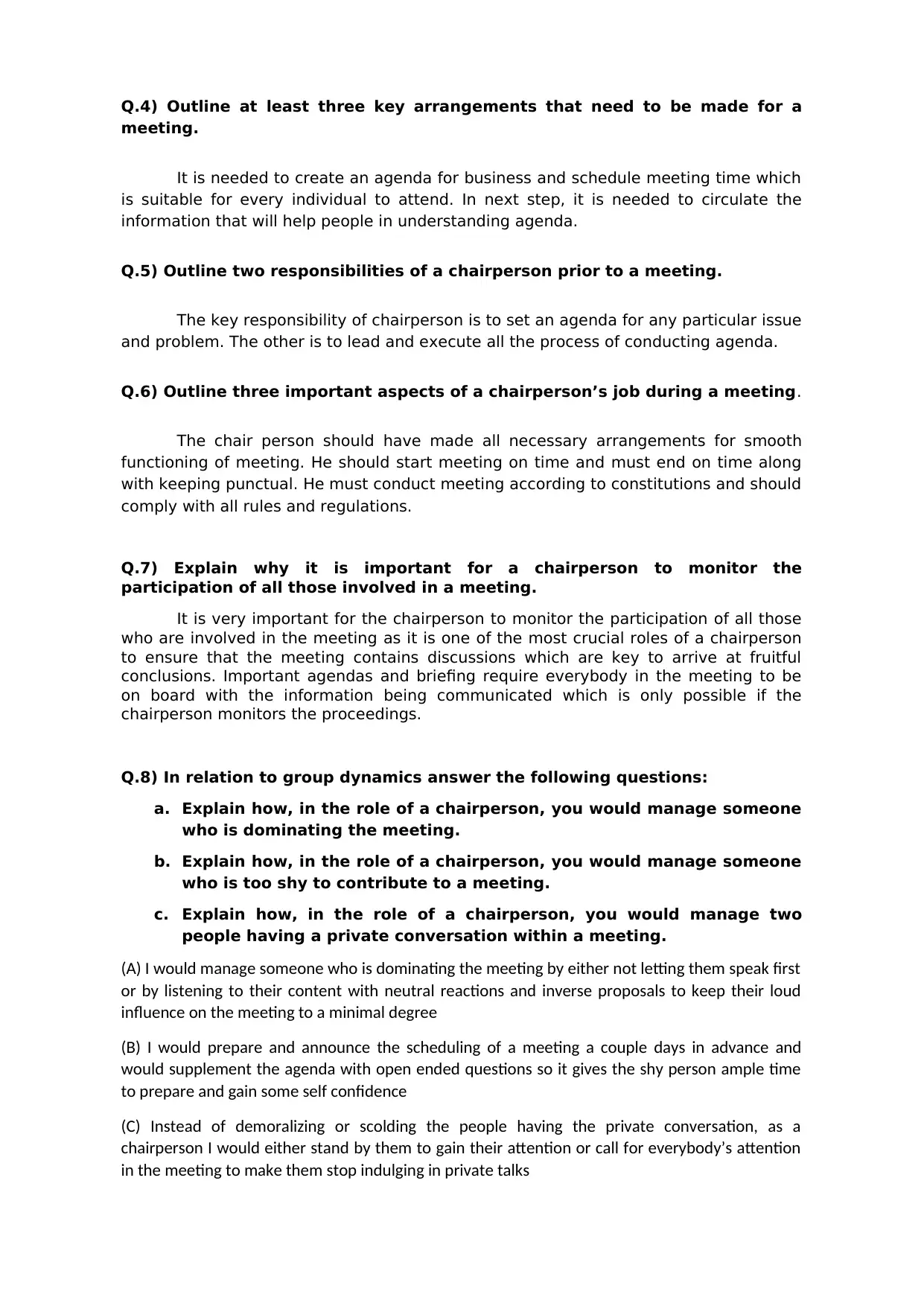
Q.4) Outline at least three key arrangements that need to be made for a
meeting.
It is needed to create an agenda for business and schedule meeting time which
is suitable for every individual to attend. In next step, it is needed to circulate the
information that will help people in understanding agenda.
Q.5) Outline two responsibilities of a chairperson prior to a meeting.
The key responsibility of chairperson is to set an agenda for any particular issue
and problem. The other is to lead and execute all the process of conducting agenda.
Q.6) Outline three important aspects of a chairperson’s job during a meeting.
The chair person should have made all necessary arrangements for smooth
functioning of meeting. He should start meeting on time and must end on time along
with keeping punctual. He must conduct meeting according to constitutions and should
comply with all rules and regulations.
Q.7) Explain why it is important for a chairperson to monitor the
participation of all those involved in a meeting.
It is very important for the chairperson to monitor the participation of all those
who are involved in the meeting as it is one of the most crucial roles of a chairperson
to ensure that the meeting contains discussions which are key to arrive at fruitful
conclusions. Important agendas and briefing require everybody in the meeting to be
on board with the information being communicated which is only possible if the
chairperson monitors the proceedings.
Q.8) In relation to group dynamics answer the following questions:
a. Explain how, in the role of a chairperson, you would manage someone
who is dominating the meeting.
b. Explain how, in the role of a chairperson, you would manage someone
who is too shy to contribute to a meeting.
c. Explain how, in the role of a chairperson, you would manage two
people having a private conversation within a meeting.
(A) I would manage someone who is dominating the meeting by either not letting them speak first
or by listening to their content with neutral reactions and inverse proposals to keep their loud
influence on the meeting to a minimal degree
(B) I would prepare and announce the scheduling of a meeting a couple days in advance and
would supplement the agenda with open ended questions so it gives the shy person ample time
to prepare and gain some self confidence
(C) Instead of demoralizing or scolding the people having the private conversation, as a
chairperson I would either stand by them to gain their attention or call for everybody’s attention
in the meeting to make them stop indulging in private talks
meeting.
It is needed to create an agenda for business and schedule meeting time which
is suitable for every individual to attend. In next step, it is needed to circulate the
information that will help people in understanding agenda.
Q.5) Outline two responsibilities of a chairperson prior to a meeting.
The key responsibility of chairperson is to set an agenda for any particular issue
and problem. The other is to lead and execute all the process of conducting agenda.
Q.6) Outline three important aspects of a chairperson’s job during a meeting.
The chair person should have made all necessary arrangements for smooth
functioning of meeting. He should start meeting on time and must end on time along
with keeping punctual. He must conduct meeting according to constitutions and should
comply with all rules and regulations.
Q.7) Explain why it is important for a chairperson to monitor the
participation of all those involved in a meeting.
It is very important for the chairperson to monitor the participation of all those
who are involved in the meeting as it is one of the most crucial roles of a chairperson
to ensure that the meeting contains discussions which are key to arrive at fruitful
conclusions. Important agendas and briefing require everybody in the meeting to be
on board with the information being communicated which is only possible if the
chairperson monitors the proceedings.
Q.8) In relation to group dynamics answer the following questions:
a. Explain how, in the role of a chairperson, you would manage someone
who is dominating the meeting.
b. Explain how, in the role of a chairperson, you would manage someone
who is too shy to contribute to a meeting.
c. Explain how, in the role of a chairperson, you would manage two
people having a private conversation within a meeting.
(A) I would manage someone who is dominating the meeting by either not letting them speak first
or by listening to their content with neutral reactions and inverse proposals to keep their loud
influence on the meeting to a minimal degree
(B) I would prepare and announce the scheduling of a meeting a couple days in advance and
would supplement the agenda with open ended questions so it gives the shy person ample time
to prepare and gain some self confidence
(C) Instead of demoralizing or scolding the people having the private conversation, as a
chairperson I would either stand by them to gain their attention or call for everybody’s attention
in the meeting to make them stop indulging in private talks
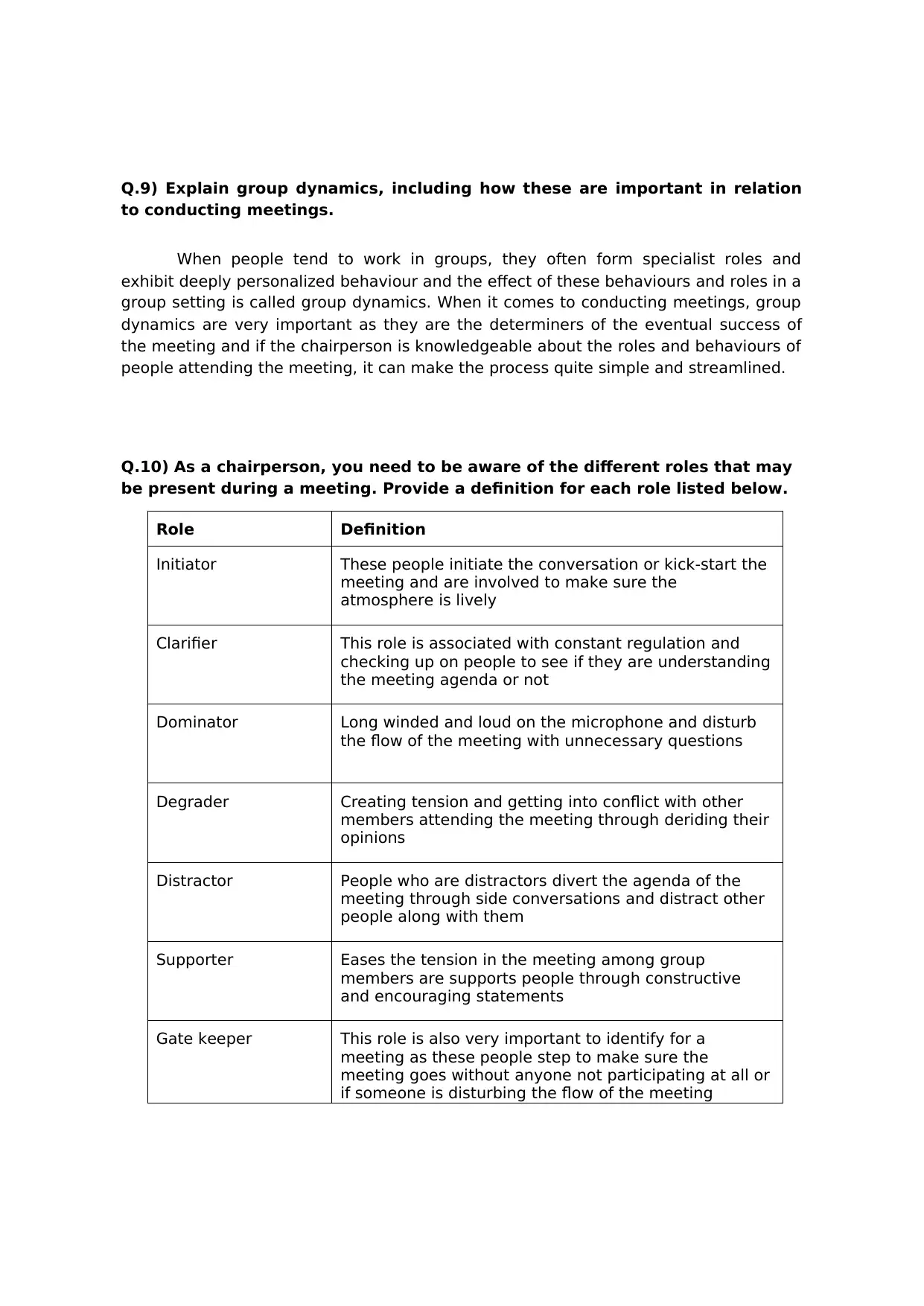
Q.9) Explain group dynamics, including how these are important in relation
to conducting meetings.
When people tend to work in groups, they often form specialist roles and
exhibit deeply personalized behaviour and the effect of these behaviours and roles in a
group setting is called group dynamics. When it comes to conducting meetings, group
dynamics are very important as they are the determiners of the eventual success of
the meeting and if the chairperson is knowledgeable about the roles and behaviours of
people attending the meeting, it can make the process quite simple and streamlined.
Q.10) As a chairperson, you need to be aware of the different roles that may
be present during a meeting. Provide a definition for each role listed below.
Role Definition
Initiator These people initiate the conversation or kick-start the
meeting and are involved to make sure the
atmosphere is lively
Clarifier This role is associated with constant regulation and
checking up on people to see if they are understanding
the meeting agenda or not
Dominator Long winded and loud on the microphone and disturb
the flow of the meeting with unnecessary questions
Degrader Creating tension and getting into conflict with other
members attending the meeting through deriding their
opinions
Distractor People who are distractors divert the agenda of the
meeting through side conversations and distract other
people along with them
Supporter Eases the tension in the meeting among group
members are supports people through constructive
and encouraging statements
Gate keeper This role is also very important to identify for a
meeting as these people step to make sure the
meeting goes without anyone not participating at all or
if someone is disturbing the flow of the meeting
to conducting meetings.
When people tend to work in groups, they often form specialist roles and
exhibit deeply personalized behaviour and the effect of these behaviours and roles in a
group setting is called group dynamics. When it comes to conducting meetings, group
dynamics are very important as they are the determiners of the eventual success of
the meeting and if the chairperson is knowledgeable about the roles and behaviours of
people attending the meeting, it can make the process quite simple and streamlined.
Q.10) As a chairperson, you need to be aware of the different roles that may
be present during a meeting. Provide a definition for each role listed below.
Role Definition
Initiator These people initiate the conversation or kick-start the
meeting and are involved to make sure the
atmosphere is lively
Clarifier This role is associated with constant regulation and
checking up on people to see if they are understanding
the meeting agenda or not
Dominator Long winded and loud on the microphone and disturb
the flow of the meeting with unnecessary questions
Degrader Creating tension and getting into conflict with other
members attending the meeting through deriding their
opinions
Distractor People who are distractors divert the agenda of the
meeting through side conversations and distract other
people along with them
Supporter Eases the tension in the meeting among group
members are supports people through constructive
and encouraging statements
Gate keeper This role is also very important to identify for a
meeting as these people step to make sure the
meeting goes without anyone not participating at all or
if someone is disturbing the flow of the meeting
⊘ This is a preview!⊘
Do you want full access?
Subscribe today to unlock all pages.

Trusted by 1+ million students worldwide
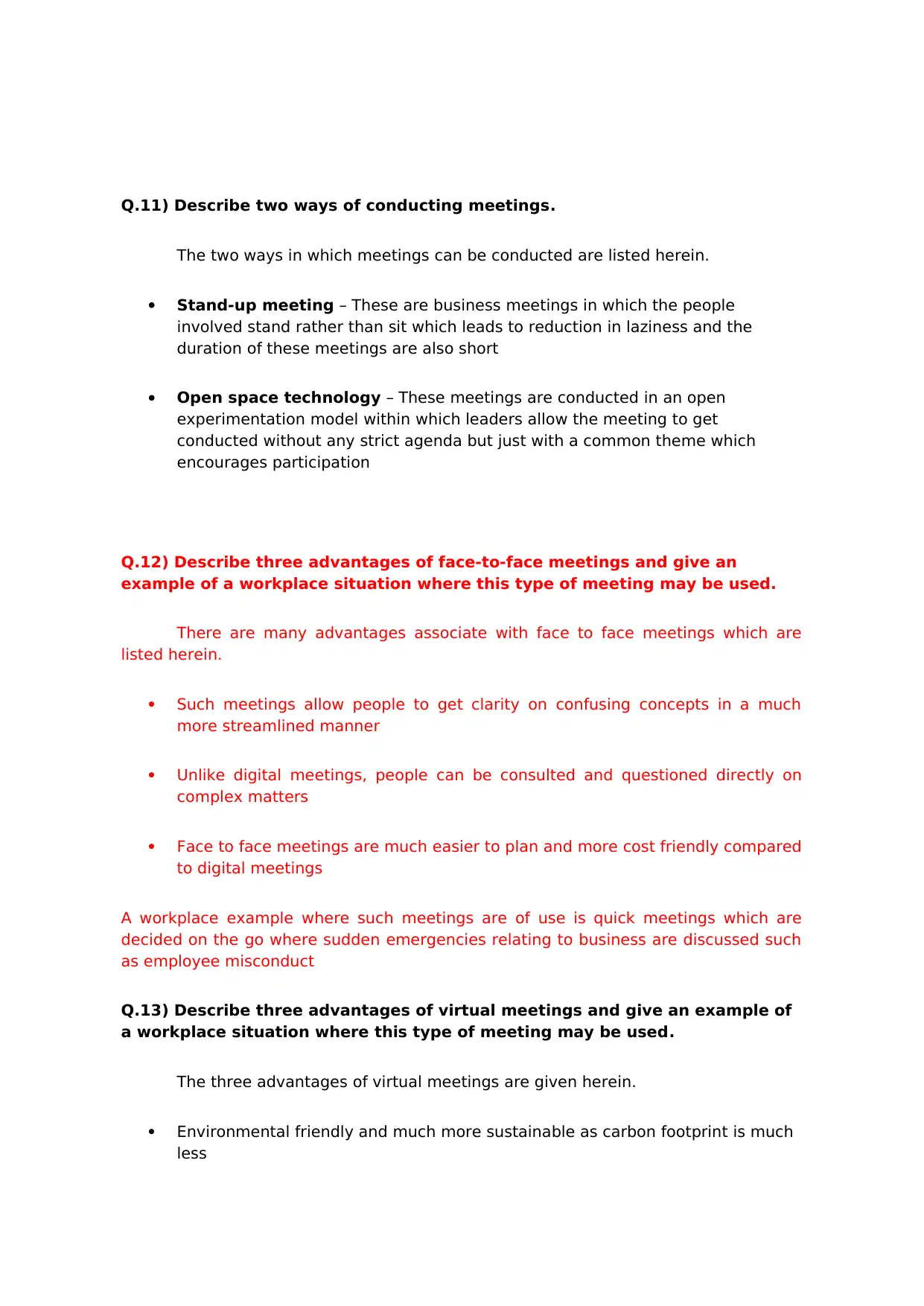
Q.11) Describe two ways of conducting meetings.
The two ways in which meetings can be conducted are listed herein.
Stand-up meeting – These are business meetings in which the people
involved stand rather than sit which leads to reduction in laziness and the
duration of these meetings are also short
Open space technology – These meetings are conducted in an open
experimentation model within which leaders allow the meeting to get
conducted without any strict agenda but just with a common theme which
encourages participation
Q.12) Describe three advantages of face-to-face meetings and give an
example of a workplace situation where this type of meeting may be used.
There are many advantages associate with face to face meetings which are
listed herein.
Such meetings allow people to get clarity on confusing concepts in a much
more streamlined manner
Unlike digital meetings, people can be consulted and questioned directly on
complex matters
Face to face meetings are much easier to plan and more cost friendly compared
to digital meetings
A workplace example where such meetings are of use is quick meetings which are
decided on the go where sudden emergencies relating to business are discussed such
as employee misconduct
Q.13) Describe three advantages of virtual meetings and give an example of
a workplace situation where this type of meeting may be used.
The three advantages of virtual meetings are given herein.
Environmental friendly and much more sustainable as carbon footprint is much
less
The two ways in which meetings can be conducted are listed herein.
Stand-up meeting – These are business meetings in which the people
involved stand rather than sit which leads to reduction in laziness and the
duration of these meetings are also short
Open space technology – These meetings are conducted in an open
experimentation model within which leaders allow the meeting to get
conducted without any strict agenda but just with a common theme which
encourages participation
Q.12) Describe three advantages of face-to-face meetings and give an
example of a workplace situation where this type of meeting may be used.
There are many advantages associate with face to face meetings which are
listed herein.
Such meetings allow people to get clarity on confusing concepts in a much
more streamlined manner
Unlike digital meetings, people can be consulted and questioned directly on
complex matters
Face to face meetings are much easier to plan and more cost friendly compared
to digital meetings
A workplace example where such meetings are of use is quick meetings which are
decided on the go where sudden emergencies relating to business are discussed such
as employee misconduct
Q.13) Describe three advantages of virtual meetings and give an example of
a workplace situation where this type of meeting may be used.
The three advantages of virtual meetings are given herein.
Environmental friendly and much more sustainable as carbon footprint is much
less
Paraphrase This Document
Need a fresh take? Get an instant paraphrase of this document with our AI Paraphraser
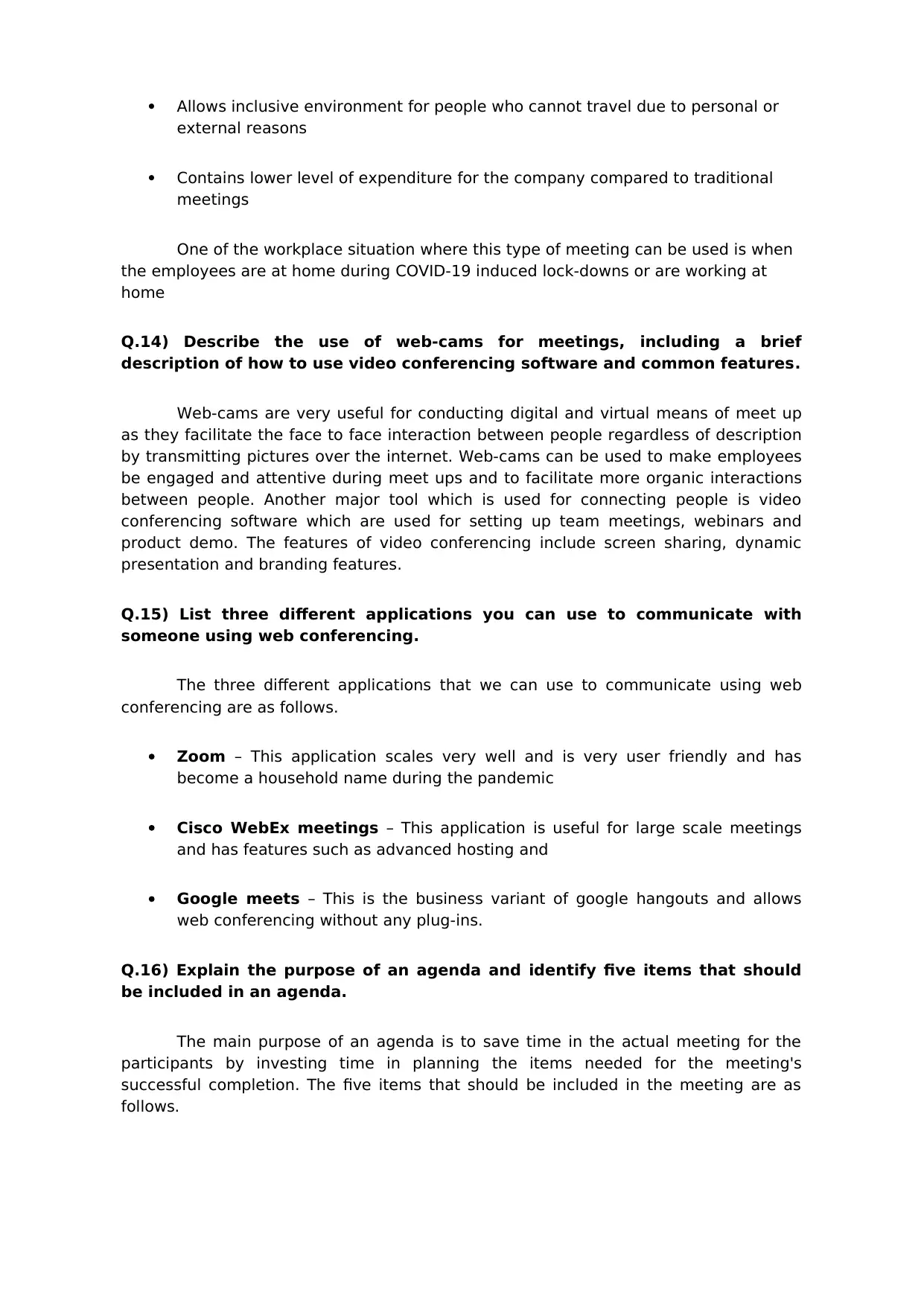
Allows inclusive environment for people who cannot travel due to personal or
external reasons
Contains lower level of expenditure for the company compared to traditional
meetings
One of the workplace situation where this type of meeting can be used is when
the employees are at home during COVID-19 induced lock-downs or are working at
home
Q.14) Describe the use of web-cams for meetings, including a brief
description of how to use video conferencing software and common features.
Web-cams are very useful for conducting digital and virtual means of meet up
as they facilitate the face to face interaction between people regardless of description
by transmitting pictures over the internet. Web-cams can be used to make employees
be engaged and attentive during meet ups and to facilitate more organic interactions
between people. Another major tool which is used for connecting people is video
conferencing software which are used for setting up team meetings, webinars and
product demo. The features of video conferencing include screen sharing, dynamic
presentation and branding features.
Q.15) List three different applications you can use to communicate with
someone using web conferencing.
The three different applications that we can use to communicate using web
conferencing are as follows.
Zoom – This application scales very well and is very user friendly and has
become a household name during the pandemic
Cisco WebEx meetings – This application is useful for large scale meetings
and has features such as advanced hosting and
Google meets – This is the business variant of google hangouts and allows
web conferencing without any plug-ins.
Q.16) Explain the purpose of an agenda and identify five items that should
be included in an agenda.
The main purpose of an agenda is to save time in the actual meeting for the
participants by investing time in planning the items needed for the meeting's
successful completion. The five items that should be included in the meeting are as
follows.
external reasons
Contains lower level of expenditure for the company compared to traditional
meetings
One of the workplace situation where this type of meeting can be used is when
the employees are at home during COVID-19 induced lock-downs or are working at
home
Q.14) Describe the use of web-cams for meetings, including a brief
description of how to use video conferencing software and common features.
Web-cams are very useful for conducting digital and virtual means of meet up
as they facilitate the face to face interaction between people regardless of description
by transmitting pictures over the internet. Web-cams can be used to make employees
be engaged and attentive during meet ups and to facilitate more organic interactions
between people. Another major tool which is used for connecting people is video
conferencing software which are used for setting up team meetings, webinars and
product demo. The features of video conferencing include screen sharing, dynamic
presentation and branding features.
Q.15) List three different applications you can use to communicate with
someone using web conferencing.
The three different applications that we can use to communicate using web
conferencing are as follows.
Zoom – This application scales very well and is very user friendly and has
become a household name during the pandemic
Cisco WebEx meetings – This application is useful for large scale meetings
and has features such as advanced hosting and
Google meets – This is the business variant of google hangouts and allows
web conferencing without any plug-ins.
Q.16) Explain the purpose of an agenda and identify five items that should
be included in an agenda.
The main purpose of an agenda is to save time in the actual meeting for the
participants by investing time in planning the items needed for the meeting's
successful completion. The five items that should be included in the meeting are as
follows.
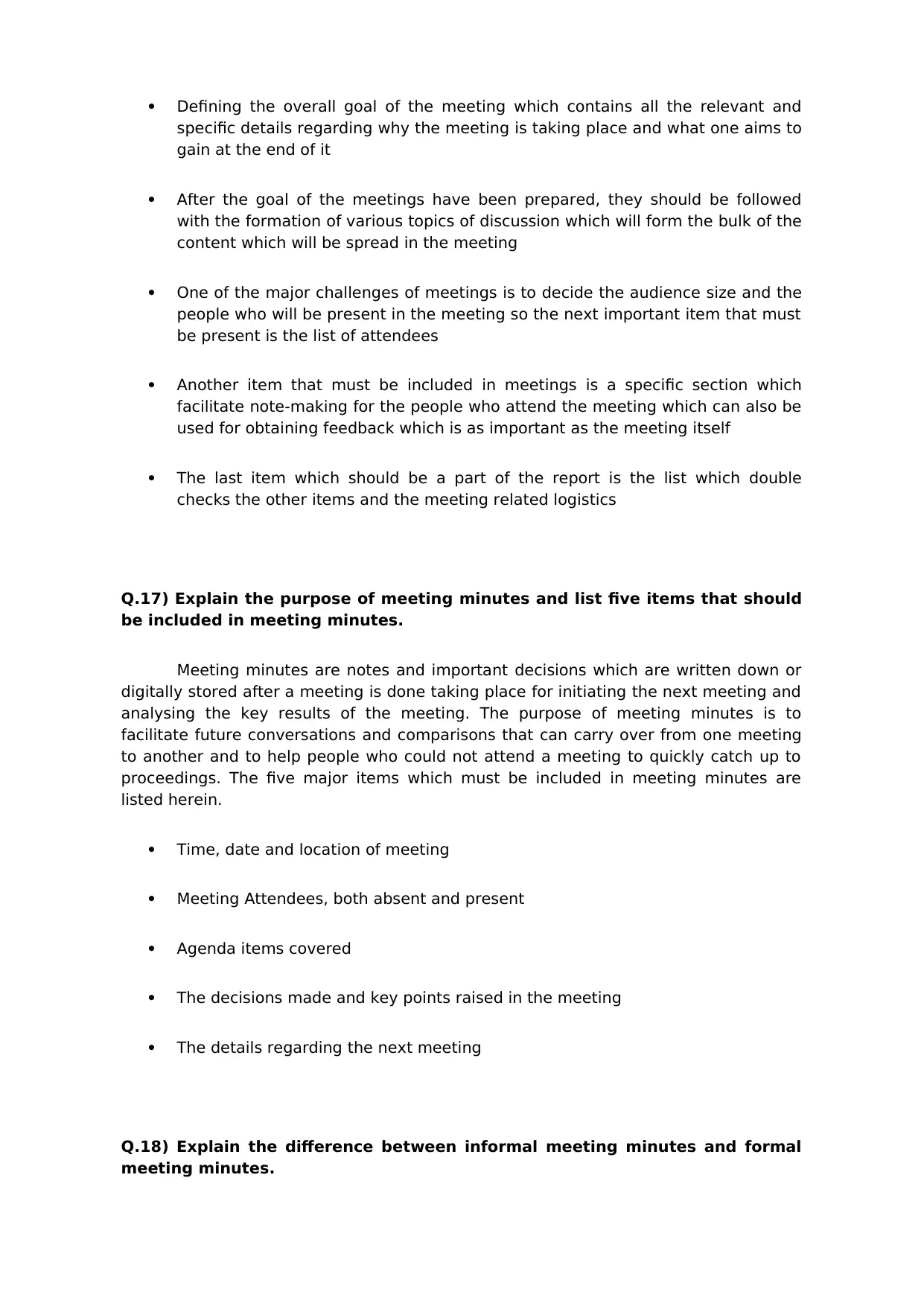
Defining the overall goal of the meeting which contains all the relevant and
specific details regarding why the meeting is taking place and what one aims to
gain at the end of it
After the goal of the meetings have been prepared, they should be followed
with the formation of various topics of discussion which will form the bulk of the
content which will be spread in the meeting
One of the major challenges of meetings is to decide the audience size and the
people who will be present in the meeting so the next important item that must
be present is the list of attendees
Another item that must be included in meetings is a specific section which
facilitate note-making for the people who attend the meeting which can also be
used for obtaining feedback which is as important as the meeting itself
The last item which should be a part of the report is the list which double
checks the other items and the meeting related logistics
Q.17) Explain the purpose of meeting minutes and list five items that should
be included in meeting minutes.
Meeting minutes are notes and important decisions which are written down or
digitally stored after a meeting is done taking place for initiating the next meeting and
analysing the key results of the meeting. The purpose of meeting minutes is to
facilitate future conversations and comparisons that can carry over from one meeting
to another and to help people who could not attend a meeting to quickly catch up to
proceedings. The five major items which must be included in meeting minutes are
listed herein.
Time, date and location of meeting
Meeting Attendees, both absent and present
Agenda items covered
The decisions made and key points raised in the meeting
The details regarding the next meeting
Q.18) Explain the difference between informal meeting minutes and formal
meeting minutes.
specific details regarding why the meeting is taking place and what one aims to
gain at the end of it
After the goal of the meetings have been prepared, they should be followed
with the formation of various topics of discussion which will form the bulk of the
content which will be spread in the meeting
One of the major challenges of meetings is to decide the audience size and the
people who will be present in the meeting so the next important item that must
be present is the list of attendees
Another item that must be included in meetings is a specific section which
facilitate note-making for the people who attend the meeting which can also be
used for obtaining feedback which is as important as the meeting itself
The last item which should be a part of the report is the list which double
checks the other items and the meeting related logistics
Q.17) Explain the purpose of meeting minutes and list five items that should
be included in meeting minutes.
Meeting minutes are notes and important decisions which are written down or
digitally stored after a meeting is done taking place for initiating the next meeting and
analysing the key results of the meeting. The purpose of meeting minutes is to
facilitate future conversations and comparisons that can carry over from one meeting
to another and to help people who could not attend a meeting to quickly catch up to
proceedings. The five major items which must be included in meeting minutes are
listed herein.
Time, date and location of meeting
Meeting Attendees, both absent and present
Agenda items covered
The decisions made and key points raised in the meeting
The details regarding the next meeting
Q.18) Explain the difference between informal meeting minutes and formal
meeting minutes.
⊘ This is a preview!⊘
Do you want full access?
Subscribe today to unlock all pages.

Trusted by 1+ million students worldwide
1 out of 34
Related Documents
Your All-in-One AI-Powered Toolkit for Academic Success.
+13062052269
info@desklib.com
Available 24*7 on WhatsApp / Email
![[object Object]](/_next/static/media/star-bottom.7253800d.svg)
Unlock your academic potential
Copyright © 2020–2025 A2Z Services. All Rights Reserved. Developed and managed by ZUCOL.





